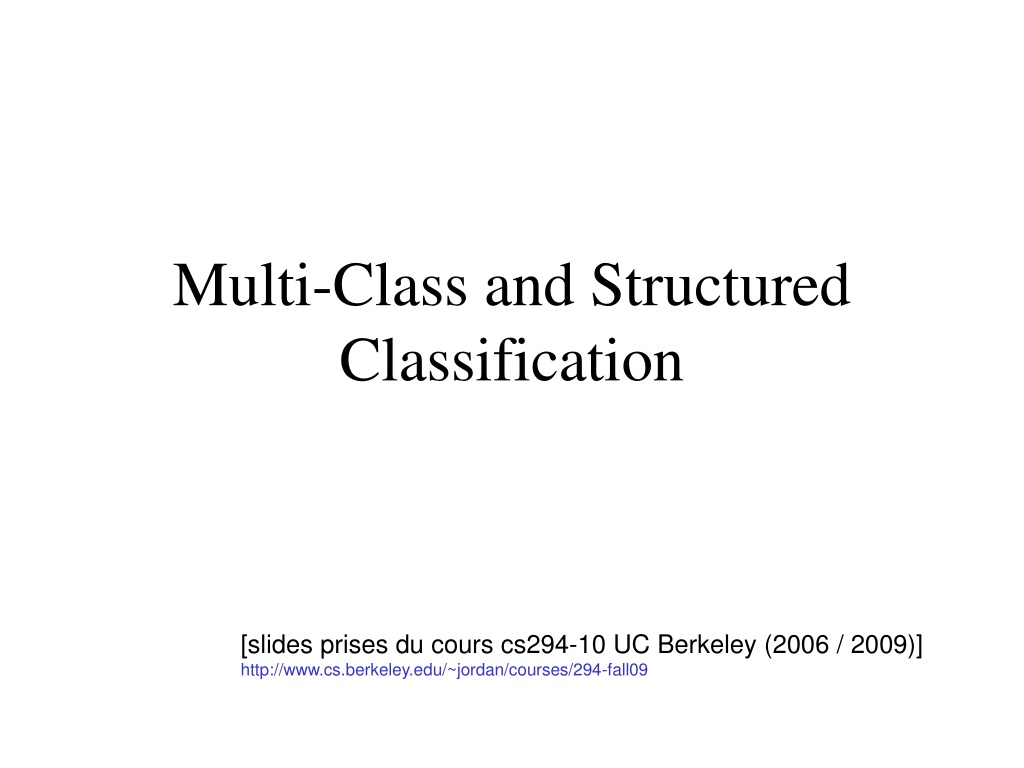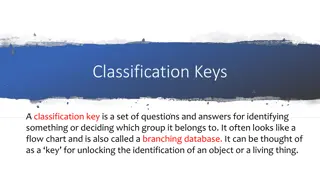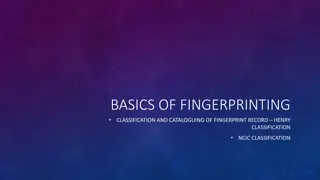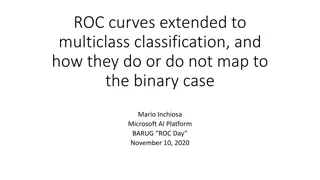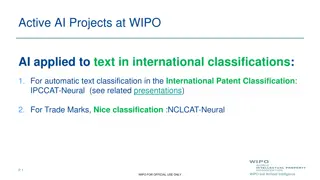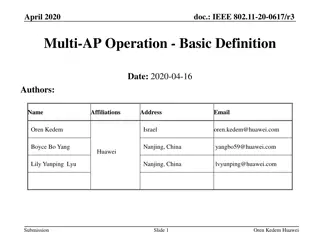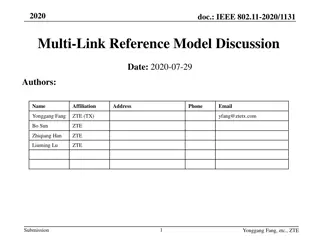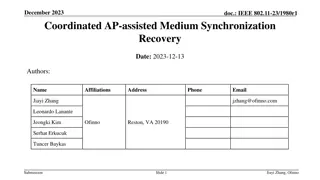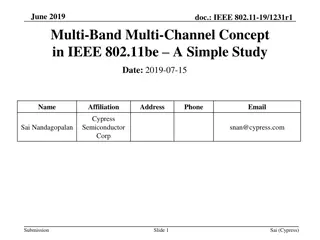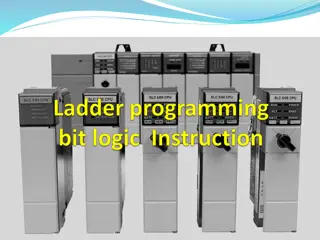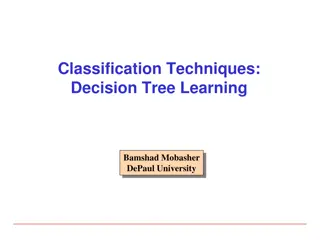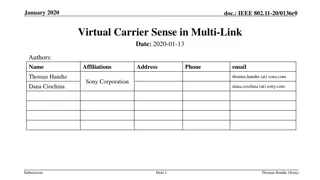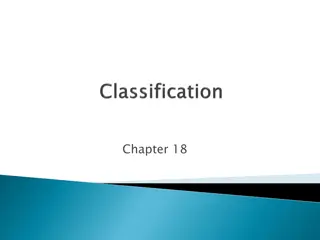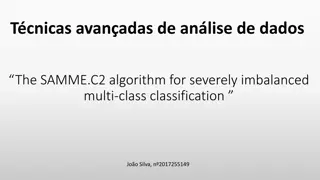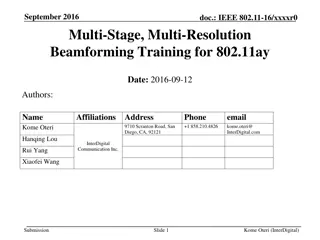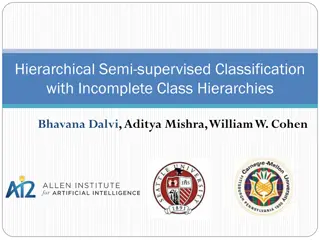Multi-Class and Structured Classification
This presentation covers topics like basic classification in machine learning, structured classification, multi-class classification approaches, generative models, nearest neighbor, decision trees, and multi-label classification. It discusses various classification techniques and their applications in different domains. The slides provide insights into multi-class frameworks, purity of leaves in decision trees, generative modeling advantages and drawbacks, and more.
Download Presentation

Please find below an Image/Link to download the presentation.
The content on the website is provided AS IS for your information and personal use only. It may not be sold, licensed, or shared on other websites without obtaining consent from the author.If you encounter any issues during the download, it is possible that the publisher has removed the file from their server.
You are allowed to download the files provided on this website for personal or commercial use, subject to the condition that they are used lawfully. All files are the property of their respective owners.
The content on the website is provided AS IS for your information and personal use only. It may not be sold, licensed, or shared on other websites without obtaining consent from the author.
E N D
Presentation Transcript
Multi-Class and Structured Classification [slides prises du cours cs294-10 UC Berkeley (2006 / 2009)] http://www.cs.berkeley.edu/~jordan/courses/294-fall09
Basic Classification in ML Input Output Spam filtering Binary !!!!$$$!!!! Multi-Class Character recognition C [thanks to Ben Taskar for slide!]
Structured Classification Input Output Handwriting recognition Structured output brace building tree 3D object recognition [thanks to Ben Taskar for slide!]
Multi-Class Classification Multi-class classification : direct approaches Nearest Neighbor Generative approach & Na ve Bayes Linear classification: geometry Perceptron K-class (polychotomous) logistic regression K-class SVM Multi-class classification through binary classification One-vs-All All-vs-all Others Calibration
Multi-label classification Is it eatable? Is it a banana? Is it a banana? Is it sweet? Is it an apple? Is it yellow? Is it a fruit? Is it an orange? Is it sweet? Is it a banana? Is it a pineapple? Is it round? Different structures Nested/ Hierarchical Exclusive/ Multi-class General/Structured
Nearest Neighbor, Decision Trees - From the classification lecture: NN and k-NN were already phrased in a multi-class framework For decision tree, want purity of leaves depending on the proportion of each class (want one class to be clearly dominant)
Generative models As in the binary case: 1. Learn p(y) and p(y|x) 2. Use Bayes rule: 3. Classify as p(y) p(x|y) p(y|x)
Generative models Advantages: Fast to train: only the data from class k is needed to learn the kthmodel (reduction by a factor k compared with other method) Works well with little data provided the model is reasonable Drawbacks: Depends on the quality of the model Doesn t model p(y|x) directly With a lot of datapoints doesn t perform as well as discriminative methods
Nave Bayes Class Assumption: Given the class the features are independent Y X1 X2 X3 X4 X5 Bag-of-words models Features If the features are discrete:
Linear classification Each class has a parameter vector (wk,bk) x is assigned to class k iff Note that we can break the symmetry and choose (w1,b1)=0 For simplicity set bk=0 (add a dimension and include it in wk) So learning goal given separable data: choose wks.t.
Geometry of Linear classification Perceptron K-class logistic regression K-class SVM
Multiclass Perceptron Online: for each datapoint Update: Predict: Advantages : Extremely simple updates (no gradient to calculate) No need to have all the data in memory (some point stay classified correctly after a while) Drawbacks If the data is not separable decrease slowly
Polychotomous logistic regression distribution in exponential form Online: for each datapoint Batch: all descent methods Especially in large dimension, use regularization small flip label probability (0,0,1) (.1,.1,.8) Advantages: Drawbacks: Smooth function Non sparse Get probability estimates
Multi-class SVM Intuitive formulation: without regularization / for the separable case Primal problem: QP Solved in the dual formulation, also Quadratic Program Main advantage: Sparsity (but not systematic) Drawbacks: Speed with SMO (heuristic use of sparsity) Need to recalculate or store xiTxj Outputs not probabilities Sparse solutions
Real world classification problems Object recognition Automated protein classification Digit recognition http://www.glue.umd.edu/~zhelin/recog.html 10 Phoneme recognition 100 300-600 The number of classes is sometimes big 50 The multi-class algorithm can be heavy [Waibel, Hanzawa, Hinton,Shikano, Lang 1989]
Combining binary classifiers One-vs-all For each class build a classifier for that class vs the rest Often very imbalanced classifiers (use asymmetric regularization) All-vs-all For each class build a classifier for that class vs the rest A priori a large number of classifiers to build but The pairwise classification are way much faster The classifications are balanced (easier to find the best regularization) so that in many cases it is clearly faster than one-vs-all
Confusion Matrix Classification of 20 news groups Predicted classes Visualize which classes are more difficult to learn Actual classes Can also be used to compare two different classifiers Cluster classes and go hierachical [Godbole, 02] [Godbole, 02] BLAST classification of proteins in 850 superfamilies
Calibration How to measure the confidence in a class prediction? Crucial for: 1. Comparison between different classifiers 2. Ranking the prediction for ROC/Precision-Recall curve 3. In several application domains having a measure of confidence for each individual answer is very important (e.g. tumor detection) Some methods have an implicit notion of confidence e.g. for SVM the distance to the class boundary relative to the size of the margin other like logistic regression have an explicit one.
Calibration Definition: the decision function f of a classifier is said to be calibrated or well-calibrated if Informally f is a good estimate of the probability of classifying correctly a new datapoint x which would have output value x. Intuitively if the raw output of a classifier is g you can calibrate it by estimating the probability of x being well classified given that g(x)=y for all y values possible.
Calibration Example: a logistic regression, or more generally calculating a Bayes posterior should yield a reasonably well-calibrated decision function.
Combining OVA calibrated classifiers Class 1 Class 2 Class 3 ++ ++ + Class 4 + + + + + ++ + + +++ ++ + + + + + + + + + + + ++ + + + + + + + + + + + + + + + + + + + +++ ++ + + + + + + + + Calibration p1 p2 p3 p4 Renormalize pother consistent (p1,p2, ,p4,pother)
Other methods for calibration Simple calibration Logistic regression Intraclass density estimation + Na ve Bayes Isotonic regression More sophisticated calibrations Calibration for A-vs-A by Hastie and Tibshirani
Local Classification b r a r e Classify using local information Ignores correlations! [thanks to Ben Taskar for slide!]
Local Classification building tree shrub ground [thanks to Ben Taskar for slide!]
Structured Classification b r a c e Use local information Exploit correlations [thanks to Ben Taskar for slide!]
Structured Classification building tree shrub ground [thanks to Ben Taskar for slide!]
Structured Classification Structured classification : direct approaches Generative approach: Markov Random Fields (Bayesian modeling with graphical models) Linear classification: Structured Perceptron Conditional Random Fields (counterpart of logistic regression) Large-margin structured classification
Structured classification Simple example HMM: Label sequence Observation sequence b r a c e Optical Character Recognition
Tree model 1 Label structure Observations
Tree model 1 Eye color inheritance: haplotype inference
Tree Model 2: Hierarchical Text Classification Root Arts Business Computers Cannes Film Festival schedule .... .... .... ... .. ...... .. Movies Television Internet Software Jobs Real Estate Y: label in tree ..... ........... (from ODP) X: webpage
Grid model Image segmentation Segmented = Labeled image
Structured Model Main idea: define scoring function which decomposes as sum of features scores k on parts p: Label examples by looking for max score: space of feasible outputs Parts = nodes, edges, etc.
Cliques and Features In undirected graphs: b r a c e b r a c e cliques = groups of completely interconnected variables In directed graphs: cliques = variable+its parents
Exponential form Once the graph is defined the model can be written in exponential form parameter vector feature vector Comparing two labellings with the likelihood ratio
Decoding and Learning Three important operations on a general structured (e.g. graphical) model: Decoding: find the right label sequence Inference: compute probabilities of labels Learning: find model + parameters w so that decoding works b r a c e HMM example: Decoding: Viterbi algorithm Inference: forward-backward algorithm Learning: e.g. transition and emission counts (case of learning a generative model from fully labeled training data)
Decoding and Learning Decoding: algorithm on the graph (eg. max-product) Use dynamic programming to take advantage of the Inference: algorithm on the graph (eg. sum-product, belief propagation, junction tree, sampling) structure Learning: inference + optimization 1. Focus of graphical model class 2. Need 2 essential concepts: 1. cliques: variables that directly depend on one another 2. features (of the cliques): some functions of the cliques
Our favorite (discriminative) algorithms the devil is in the details...
(Averaged) Perceptron For each datapoint Predict: Update: Averaged perceptron:
Example: multiclass setting Feature encoding: Predict: Update: Predict: Update:
CRF Z difficult to compute with complicated graphs Conditioned on all the observations Introduction by Hannah M.Wallach http://www.inference.phy.cam.ac.uk/hmw26/crf/ MEMM & CRF, Mayssam Sayyadian, Rob McCann anhai.cs.uiuc.edu/courses/498ad-fall04/local/my-slides/crf-students.pdf M3net No Z The margin penalty can factorize according to the problem structure Introduction by Simon Lacoste-Julien http://www.cs.berkeley.edu/~slacoste/school/cs281a/project_report.html
[thanks to Ben Taskar for slide!] Object Segmentation Results Data: [Stanford Quad by Segbot] Trained on 30,000 point scene Tested on 3,000,000 point scenes Laser Range Finder Segbot M. Montemerlo S. Thrun Evaluated on 180,000 point scene Model Error Local learning Local prediction Local learning +smoothing Structured method [Taskar+al 04, Anguelov+Taskar+al 05] building tree shrub ground 32% 27% 7%
